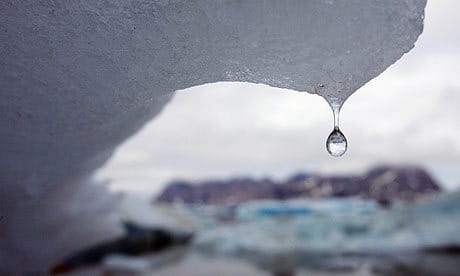A cast-iron case for climate sceptics
Philippa Skett on the ice caps leaking iron into the ocean

Climate change sceptics were thrown a cast-iron lifeline this week when it was revealed that the melting of ice caps containing iron could potentially be biologically beneficial. However, with some predicting that the iron equivalent of of 3,000 Boeing 747s may be leaked into the oceans per year, how exactly could this be seen to be environmentally advantageous?
A research team, consisting of scientists from institutions across the UK, has found that melting ice sheets in Greenland contain iron, which could influence phytoplankton growth when released.
The water exiting from beneath the melting ice sheet delivers a boost of bioavailable iron during the summer, which in turn will boost phytoplankton biosynthesis.
This phytoplankton growth will, in turn, increase their total carbon capture capabilities, thus allegedly buffering the effect of global warming.
Also, by being at the bottom of the food chain, more phytoplankton means more biomass in the oceans too.
It is too early to estimate how much iron will be leaked into the sea globally, but after examining the data from Greenland, it is predicted that between 400,000 and 2,500,000 tonnes of bioavailable iron per year will enter the surrounding oceans. Combined with estimates for iron influx from the Antarctica too, that the weight of around 125 Eiffel Towers, or 3,000 Boeing 747s being added to the ocean, each year.
Despite iron being the fourth most abundant element in the Earth’s crust, it is generally not biologically available for organisms, due to existing as an unreactive form within minerals. A couple of decades ago, some groups experimented with dumping large quantities of iron into the sea to accelerate plankton growth. It seems that in reality, this is already happening, with the melting ice caps contributing to the iron instead of ambitious researchers.
However, new evidence showing that glaciers of the West coast of Antarctica are now irreversibly melting into the sea, and the recent Intergovernmental Panel on Climate Change (IPCC) report stating that carbon emissions are now growing at almost double the rate seen four years ago, climate change is very much a real and damaging phenomenon.
However, many politicians, and in fact many members of the public are still considered to be “climate sceptic.”
But why is this? Hasn’t science made it perfectly clear how legitimate concerns over climate change are?
A previous study has found that 1 in 2 people actually think that the scientific community is divided in its opinion in climate change, due to media such as newspapers perpetuating through balanced articles that the argument for climate change is balanced too.
Not only that, but politicians, including those in power that can make decisions to address global warming, are split over the consensus of climate change. In 2013 in the USA, anonymous billionaire conservatives, acting to mobilise against Obama’s efforts to act on global warming, donated $120 million to more than 100 anti-climate groups and think-tanks in an attempt to discredit climate change science.
Science like this, despite being of the public interest and credible in nature, may be used in the future by such powers to strengthen arguments such as the globe is able to “right itself” against carbon fluctuations, or that increasing carbon emissions are unstoppably cyclic in nature. In the short term, it is no doubt that this iron influx may bolster the biomass and biodiversity in the oceans, but doesn’t provide any long term solutions.
Climate change sceptics need all the help they can get, and this new research may well be a fragile lifeline they will use to hook in more gullible guppies in the future. Unfortunately, such guppies can’t be sustained by phytoplankton boosts forever; no matter how much more the ice caps melt.







